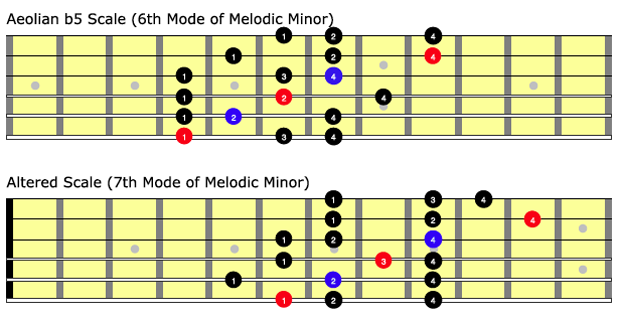Beyond the Fretboard: Ways to Improvise Over a Breakdown
Add a progressive flavor to the breakdown in your tune.

The "breakdown" has become a common yet divisive aspect of the new sub-genres in metal music.
Basically, if the sub-genre has a "core" in its title (metalcore, deathcore, sludgecore, you get the idea), you're likely to hear a breakdown or three.
The traditional approach to breakdowns is that they be heavily percussive and rhythmic in their delivery. This means the entire band is in lockstep with the same groove-based and sometimes staccato-sounding pattern. The result is a very precise, tight and often catchy section to a song, which can even eclipse the main chorus.
The problem is that the breakdown also can be musically limiting. Most times, the same one or two power chords are palm-muted in predictable succession with little or no variety. Some bands have tried to fight their way out of this corner by making the rhythmic patterns more complicated and oddly timed, but then it can lose its catchy appeal.
Beyond what has already been said, I'm not trying to make a case for the musical validity of breakdowns. I know some people find them annoying, others hate them, while still others find them to be a guilty pleasure of head banging euphoria. It is what it is.
For those of you who enjoy breakdowns, I want to discuss how one can add a 'progressive' flavor to them. This all stemmed from a song I was recently writing where the intro opened up with a rather ugly-sounding breakdown. I say it was ugly because I was basically chugging away at a diminished power chord (simply the root and the flat 5th, otherwise known as a tritone). The rest of the song ended up being very uptempo, and there were some potential sections where I thought about adding a guitar solo. But I kept coming back to this idea of adding a guitar solo right out of the gates, over the breakdown.
This is not a new idea, yet it is still an uncommon occurrence in your average metal song. And if you do hear something like this, it's usually more of a lead riff, which falls into a diatonic box (usually pentatonic or natural minor feel, occasionally harmonic minor).
All the latest guitar news, interviews, lessons, reviews, deals and more, direct to your inbox!
But how much inspiration can we really get out of a sludgy and awkward rhythmic pattern played with diminished power chords?
Well, as I've said in previous columns, it all depends on your perspective. On the one hand, we have no discernible melody or chord progression to guide us in our guitar soloing endeavors. On the other hand, we have lots of harmonic freedom when we're dealing with a diminished power chord.
As some of you probably know, a power chord is technically a dyad (meaning only two notes are involved). This makes things rather ambiguous as to whether we're dealing with a major or a minor progression. The major or minor 3rd interval, which is crucial in the building of triads, is omitted in the case of power chords. For traditional rock songs, this is not so much of a problem because the main melody often will tell us the quality (typically major, minor or dominant)
But what about our example of a breakdown? There's usually no melody involved and, again, it's often percussively and rhythmically focused. This puts the lead guitarist almost completely in the driver's seat. The only note you have to adhere to is the diminished 5th.
So you have some obvious choices like the blues scale, or you could derive a few licks from a diminished arpeggio, but we have many more options. Without the 3rd interval, we also can view this diminished 5th as an augmented 4th. It's still the same note and same interval distance from the root, but now we can look at a whole bunch of scales, which sometimes can include both the major 3rd and this augmented 4th.
Check out the diagrams of the following scales, which contain the augmented 4th/diminished 5th below:
(The red circle indicates the root note, the blue circle indicates the sharp 4 / flat 5)


In particular, playing one of the Lydian scales over our hypothetical breakdown really changes the whole vibe and intent of the diminished power chords. It might sound weird at first, but it only takes a few moments for your ears to adjust and acclimate to this sound. The Lydian dominant scale can be especially effective because it has that tritone relationship between its major 3rd and minor 7th intervals. If you want to really throw a curve ball, try the Lydian #5 or the altered scale. This will give your solo an unexpected "jazzy" sound.
Try recording a breakdown involving only diminished power chords and use the above scales as your jumping off point. You could also create interesting licks that mimic the rhythmic patterns you write. If you're into this type of metal but feel that most breakdowns have gotten stale, then give this approach a shot and see where it takes you.
Chris Breen is a New Jersey-based guitarist with 14 years of experience under his belt. He, along with his brother Jon (on drums) started the two-piece metal project known as SCARSIC in 2011. Due to a lack of members, Chris tracked guitars, bass and vocals for their self titled four-song demo (available on iTunes, Spotify and Rhapsody). They have recently been joined by bassist Bill Loucas and are writing new material. Chris also is part of an all-acoustic side project known as Eyes Turn Stone. Chris teaches guitar lessons as well (in person or via Skype). If you're interested in taking lessons with Chris, visit BreenMusicLessons.com for more info.
